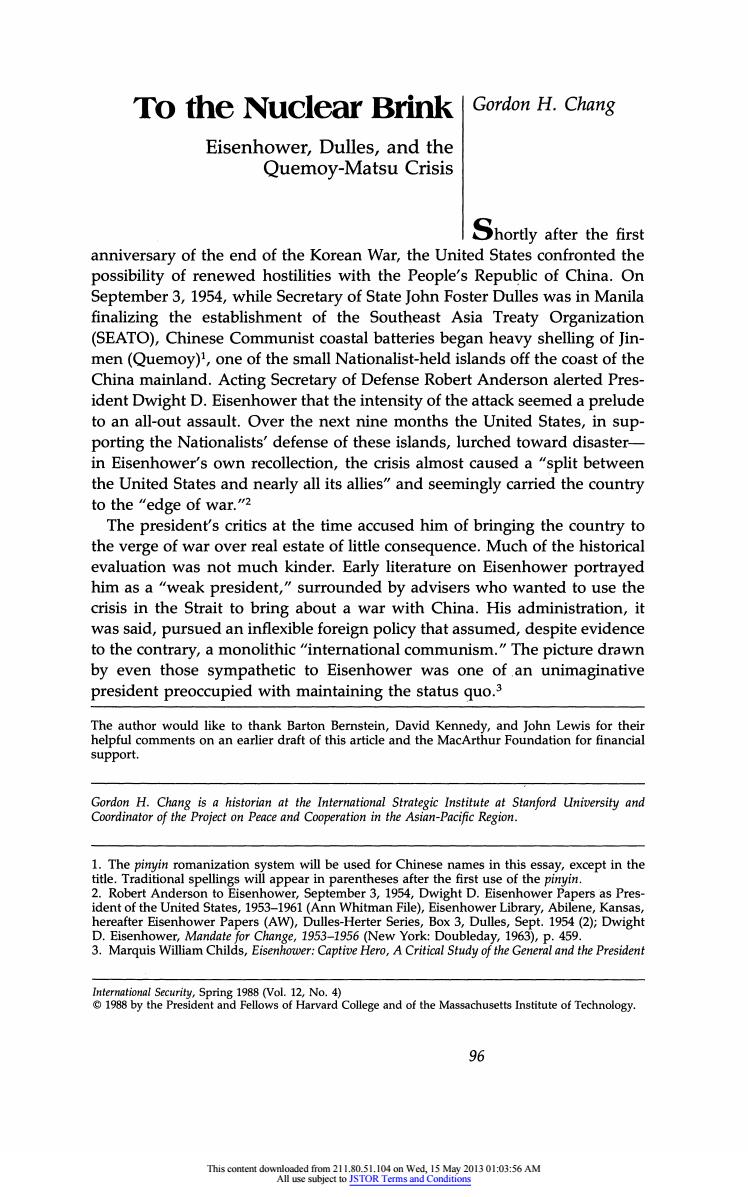正在加载图片...

To the Nuclear Brink Gordon H.Chang Eisenhower,Dulles,and the Quemoy-Matsu Crisis Shortly after the first anniversary of the end of the Korean War,the United States confronted the possibility of renewed hostilities with the People's Republic of China.On September 3,1954,while Secretary of State John Foster Dulles was in Manila finalizing the establishment of the Southeast Asia Treaty Organization (SEATO),Chinese Communist coastal batteries began heavy shelling of Jin- men(Quemoy)',one of the small Nationalist-held islands off the coast of the China mainland.Acting Secretary of Defense Robert Anderson alerted Pres- ident Dwight D.Eisenhower that the intensity of the attack seemed a prelude to an all-out assault.Over the next nine months the United States,in sup- porting the Nationalists'defense of these islands,lurched toward disaster- in Eisenhower's own recollection,the crisis almost caused a "split between the United States and nearly all its allies"and seemingly carried the country to the“edge of war..w2 The president's critics at the time accused him of bringing the country to the verge of war over real estate of little consequence.Much of the historical evaluation was not much kinder.Early literature on Eisenhower portrayed him as a"weak president,"surrounded by advisers who wanted to use the crisis in the Strait to bring about a war with China.His administration,it was said,pursued an inflexible foreign policy that assumed,despite evidence to the contrary,a monolithic "international communism."The picture drawn by even those sympathetic to Eisenhower was one of an unimaginative president preoccupied with maintaining the status quo.3 The author would like to thank Barton Bernstein,David Kennedy,and John Lewis for their helpful comments on an earlier draft of this article and the MacArthur Foundation for financial support. Gordon H.Chang is a historian at the International Strategic Institute at Stanford UIniversity and Coordinator of the Project on Peace and Cooperation in the Asian-Pacific Region. 1.The pinyin romanization system will be used for Chinese names in this essay,except in the title.Traditional spellings will appear in parentheses after the first use of the pinyin. 2.Robert Anderson to Eisenhower,September 3,1954,Dwight D.Eisenhower Papers as Pres- ident of the United States,1953-1961(Ann Whitman File),Eisenhower Library,Abilene,Kansas, hereafter Eisenhower Papers (AW),Dulles-Herter Series,Box 3,Dulles,Sept.1954(2);Dwight D.Eisenhower,Mandate for Change,1953-1956(New York:Doubleday,1963),p.459. 3.Marquis William Childs,Eisenhower:Captive Hero,A Critical Study of the General and the President International Security,Spring 1988 (Vol.12,No.4) 1988 by the President and Fellows of Harvard College and of the Massachusetts Institute of Technology. 96 soamoR=2213016AMTo the Nuclear Brinik Gordon H. Chang Eisenhower, Dulles, and the Quemoy-Matsu Crisis Shortly after the first anniversary of the end of the Korean War, the United States confronted the possibility of renewed hostilities with the People's Republic of China. On September 3, 1954, while Secretary of State John Foster Dulles was in Manila finalizing the establishment of the Southeast Asia Treaty Organization (SEATO), Chinese Communist coastal batteries began heavy shelling of Jinmen (Quemoy)1, one of the small Nationalist-held islands off the coast of the China mainland. Acting Secretary of Defense Robert Anderson alerted President Dwight D. Eisenhower that the intensity of the attack seemed a prelude to an all-out assault. Over the next nine months the United States, in supporting the Nationalists' defense of these islands, lurched toward disasterin Eisenhower's own recollection, the crisis almost caused a "split between the United States and nearly all its allies" and seemingly carried the country to the "edge of war."2 The president's critics at the time accused him of bringing the country to the verge of war over real estate of little consequence. Much of the historical evaluation was not much kinder. Early literature on Eisenhower portrayed him as a "weak president," surrounded by advisers who wanted to use the crisis in the Strait to bring about a war with China. His administration, it was said, pursued an inflexible foreign policy that assumed, despite evidence to the contrary, a monolithic "international communism." The picture drawn by even those sympathetic to Eisenhower was one of an unimaginative president preoccupied with maintaining the status quo.3 The author would like to thank Barton Bernstein, David Kennedy, and John Lewis for their helpful comments on an earlier draft of this article and the MacArthur Foundation for financial support. Gordon H. Chang is a historian at the International Strategic Institute at Stanford University and Coordinator of the Project on Peace and Cooperation in the Asian-Pacific Region. International Security, Spring 1988 (Vol. 12, No. 4) C 1988 by the President and Fellows of Harvard College and of the Massachusetts Institute of Technology. 96 1. The pinyin romanization system will be used for Chinese names in this essay, except in the title. Traditional spellings will appear in parentheses after the first use of the pinyin. 2. Robert Anderson to Eisenhower, September 3, 1954, Dwight D. Eisenhower Papers as President of the United States, 1953-1961 (Ann Whitman File), Eisenhower Library, Abilene, Kansas, hereafter Eisenhower Papers (AW), Dulles-Herter Series, Box 3, Dulles, Sept. 1954 (2); Dwight D. Eisenhower, Mandate for Change, 1953-1956 (New York: Doubleday, 1963), p. 459. 3. Marquis William Childs, Eisenhower: Captive Hero, A Critical Study of the Generalnd the President This content downloaded from 211.80.51.104 on Wed, 15 May 2013 01:03:56 AM All use subject to JSTOR Terms and Conditions